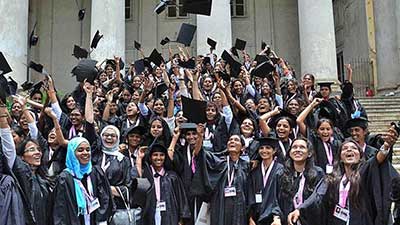Date: 24/01/2023
Relevance: GS-2: Issues Relating to Development and Management of Social Sector/Services relating to Health, Education, Human Resources.
Key Phrases: G20 presidency, National Education Policy (NEP) of 2020, India’s academic system, National Institutional Ranking Framework, Times Higher Education ranking, Global Innovation Index.
Why in News?
- With India assuming the G20 presidency, it is now time for it to join the world’s academic community as a major player.
India’s academic system:
- Lesser-known academic environment:
- Indians are well-known globally as top scientists and academics, university leaders, and key leaders in high-tech, but little is known about the academic environment from which they have emerged.
- India’s academic system is now the world’s second-largest. And, as articulated in the National Education Policy (NEP) of 2020, the country is actively pursuing reform and improvement
- Opening to the world:
- Opening to the world means making India more visible on the global academic scene and also learning about, and implementing, best practices from abroad.
- The G20 leadership is an excellent opportunity to do both. Further, one of the priority areas in education during India’s G20 presidency is ‘Strengthening Research and Promoting Innovation through Richer Collaboration’.
- Advantageous position:
- India is in a particularly advantageous position — the world sees India as an increasingly important economy and geopolitical player.
- Talent pool:
- India also plays an important role in higher education — mainly as an exporter of students and talent in many scientific fields — and especially in information technology and related fields.
- Global interest in Indian universities:
- There is a growing interest abroad in linking with Indian universities and research institutes, not only because of untapped talent but also due to disengagement from China by some Western countries.
Challenges and Opportunities:
- Unknown, complex system:
- India is not only the world’s second-largest academic system but also one of the world’s most complex and little-understood academic environments.
- Its higher education sector is fragmented, inflexible with tight subject boundaries, and of uneven quality.
- The NEP’s focus is on consolidation, with the goal of bringing flexibility and multi-disciplinary education and improving quality.
- Funding and Autonomy:
- While private sector colleges and universities will continue to fuel growth, high-quality government institutions such as the IITs and AIIMS are also expanding and improving, and will likely achieve good results if they are adequately funded and permitted to have appropriate autonomy.
- Competition among universities:
- India has set up the National Institutional Ranking Framework, which has helped fuel competition among institutions.
- Global rankings:
- India’s global ranking in scientific publications improved from the seventh position in 2010 to third in 2020.
- India ranks third in terms of the number of PhDs awarded in science and engineering.
- India’s Global Innovation Index ranking has also improved significantly, from 81 in 2014 to 40 in 2022, although it lags significantly behind the U.S. and China.
- Indian universities have not scored well in the global rankings. The highest-scoring Indian institution in the 2023 Times Higher Education ranking is the Indian Institute of Science, in the 251-300 range. Another 75 institutions are ranked lower.
- Rankings of IITs:
- The best-known institutions globally are the IITs. These do not rank well because they are small, specialized schools and not comprehensive universities, but their quality is much better than their ranking scores.
- The recent announcement that IIT-Kharagpur will establish a branch campus in Malaysia will help.
- Need for Investment:
- For India to catch up, both in the rankings and in reality, will take significant investment over a sustained period of time.
- In comparison, China over decades has invested billions of dollars to improve its top universities — and this shows in the rankings and in measures of scientific output.
Distinctiveness:
- Top quality private universities:
- There are elements of India’s academic environment that are distinctive and worth highlighting to an international audience.
- These include the emergence of about a dozen top-quality non-profit private universities, mostly funded by philanthropically minded Indians.
- This elite sector is expanding and is focused on building an international ‘brand’ for Indian higher education.
- India uses English as the main language of science and higher education, which makes it much easier to interact with the rest of the world.
- Research labs:
- India has more than 100 research laboratories in diverse areas sponsored by the Council of Scientific and Industrial Research and other Central government agencies.
- Some are outstanding in terms of their research contributions and their relationships with India’s economy.
Way Forward:
- India’s universities and their scientific prowess are an important part of a soft power strategy.
- The internationalization initiatives outlined in the NEP is an important start. India’s G20 leadership is also an excellent opportunity to exercise leadership.
- Two interesting initiatives have been suggested:
- A conference in India of leaders of universities in the G20 countries with the aim of acquainting them with India’s academic opportunities.
- Creation of a prestigious scholarship program, similar to the Fulbright program, that would provide top Indian students and faculty time in leading universities abroad and funding to bring top academics from abroad to India. China’s version of this is the China Scholarship Council.
- Indian universities, researchers, and academics also need to involve themselves in the global scientific community through participation in joint projects, international meetings, and the like.
- All this will take careful planning, sustained resources, support from the Central and State governments, and an expanded international consciousness in the Indian academic community.
Source: The Hindu
Mains Question:
Q. What are the challenges in the Indian academic system in comparison to the global academic system? How can India’s G20 presidency play a pivotal role in increasing the exposure of Indian higher education institutes on the global academic scene? Discuss.







